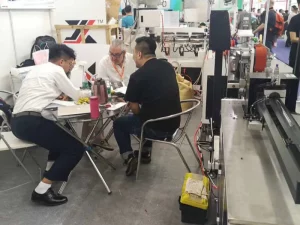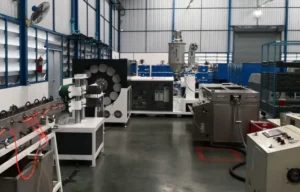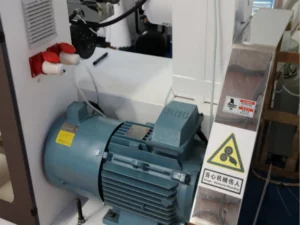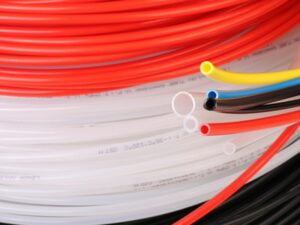In the complex world of plastic extrusion, the feeding mechanism plays a pivotal role in determining the efficiency and quality of the final product. We focus on the feeding mechanisms in extruders, especially in single screw type extruders.
The feeding mechanisms widely used in the plastics industry, utilize different feeding systems to introduce raw material into the machine. Among these, gravity feeding stands out for its simplicity and effectiveness.
This article explores the various feeding mechanisms in single screw extruders, with a particular focus on gravity feeding, contrasting it with force-fed systems, and highlighting the advantages and benefits of gravity feeding in the extrusion process.
Feeding Mechanisms in Extruders
The feeding mechanism is a crucial component of a single screw extruder. It’s responsible for ensuring a steady and consistent flow of raw material – typically in pellet or granular form – into the extruder. There are mainly two types of feeding systems used in single screw extruders: gravity feeding and force-fed (or starve-fed) systems.
Gravity Feeding System
Gravity feeding, as the name suggests, relies on gravity to guide the material from the hopper into the extruder. The material simply falls into the open feed throat of the extruder, where the rotating screw catches and conveys it forward.
Advantages of Gravity Feeding:
- Simplicity and Reliability: One of the most significant advantages of gravity feeding is its simplicity. There are no complex moving parts involved in the feeding mechanism, making it reliable and easy to maintain.
- Consistent Material Flow: Gravity feeding ensures a consistent flow of material into the extruder. This consistency is crucial for maintaining uniform product quality throughout the extrusion process.
- Reduced Wear and Tear: The lack of additional mechanical components means there’s less wear and tear compared to more complex feeding systems. This translates to lower maintenance costs and longer equipment life.
- Energy Efficiency: Gravity feeders require no additional power supply or energy, making them more energy-efficient compared to force-fed systems.
- Ease of Cleaning and Material Changeover: The simplicity of gravity feeders makes them easier to clean and quicker for material changeovers, which is particularly beneficial in applications where multiple materials are processed.
Force-fed Systems
In contrast, force-fed systems use an additional device, like a screw feeder or a ram, to actively push the material into the extruder. This system is typically used for materials with poor flow characteristics or for applications where precise control of the feed rate is essential.
Comparing Gravity and Force-fed Systems:
- Material Flow Consistency: Force-fed systems offer more precise control over the feed rate, which can be beneficial for challenging materials. However, gravity feeders provide sufficient consistency for most standard applications, making them a more straightforward and cost-effective choice.
- Complexity and Cost: Force-fed systems are more complex and expensive both in terms of initial investment and maintenance. Gravity feeders, with their minimalistic design, offer a cost-effective solution for many extrusion applications.
- Flexibility in Material Handling: Gravity feeders work best with free-flowing materials. In contrast, force-fed systems can handle a wider range of materials, including those that are more difficult to feed consistently using gravity alone.
Our improvements and innovations for the feeding mechanisms in extruders
After implementing improvements and upgrades to the gravity feeding system, we’ve achieved significant enhancements in the control of product quality during the extrusion process. The essence of this improvement lies in the strict control of the weight per meter of the product during the extrusion, directly influencing the quality of the extruded product. Previously, standard extrusion machines lacked precise control devices for this measure, leading to variability in product quality.
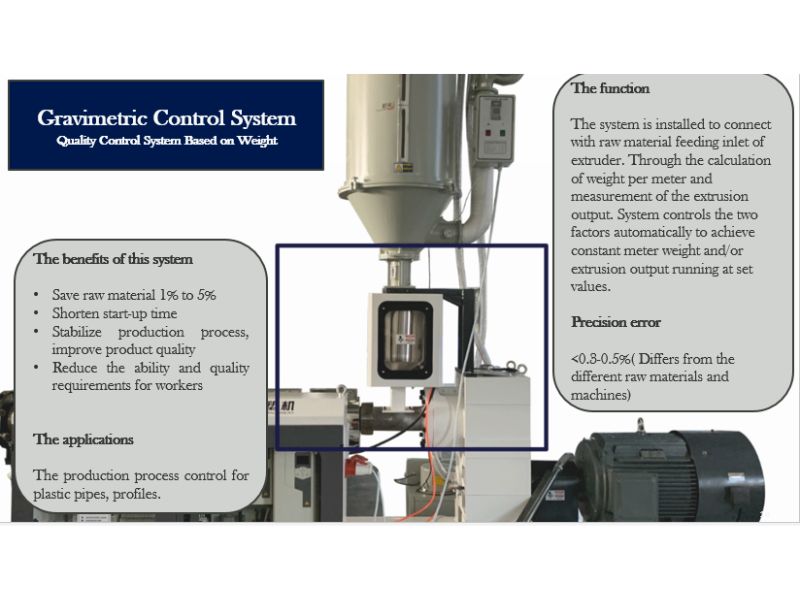
In practice, fluctuations in the density of raw materials can affect the feed rate during extrusion, thereby impacting the weight per meter and ultimately, the product quality. Manual adjustments to the traction speed or extrusion speed can temporarily compensate for these variations, but they tend to reduce the stability and efficiency of the overall extrusion process.
Moreover, the bulk density of raw materials, including powdery substances, can vary. This variation is detectable only through a system that controls the weight per meter, as it measures the weight rather than the volume of the materials. Without compensation for these fluctuations, the product quality can be adversely affected. Gravity measurement is essential in stabilizing the extrusion process for products like pipes and other linear items.
To address these challenges, the proposed solution is a system for synchronizing the weight per meter control in the extrusion molding production line. This system integrates the feeding, extrusion, and traction speeds to maintain consistent product weight, thereby stabilizing product quality and reducing raw material waste. It necessitates automatic measurement, computation, and output in a closed-loop control to achieve this objective.
The system for weight per meter synchronization is an automated solution for strictly controlling the weight of the product per meter. Its principle involves real-time monitoring of the feed rate in the extruder and automatically adjusting the production line’s traction speed to match the preset weight per meter. This control ensures a constant weight per meter for extruded products like pipes, hoses, profiles, cables, and films.
Key advantages of this system include material savings, stabilization of variations caused by raw materials, consistent control of weight per meter to minimum standards, and fixed wall thickness. It optimizes line speed, synchronizing traction speed with the feed rate, reduces startup time and waste, thereby significantly saving materials and increasing profits for businesses through reduced production costs.
For the time being, this system is standard on all our profile extruders as well as our rigid pipe extruders. Refer to our profile extrusion machine product introduction:
Conclusion
Choose from which feeding mechanisms in extruders depends on several factors, including the type of material being processed, the desired control over the feed rate, and cost considerations. While force-fed systems offer greater control, especially for challenging materials, gravity feeding remains a popular choice due to its simplicity, reliability, and cost-effectiveness. Understanding these feeding mechanisms is crucial for optimizing the extrusion process, ensuring consistent product quality, and maintaining operational efficiency in plastic manufacturing.
Tags:
Extrusion Process (1) PA Extrusion (1) Plastic Extruders (3) Reinforced Hose (2) Success Projects (1) TPE Extrusion (1) Troubleshooting (1)
